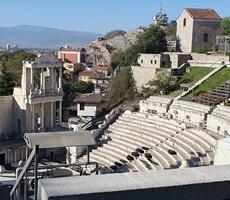
The Roman theatre of Plovdiv is one of the world's best-preserved ancient theatres.
Photo. The Roman theatre of Plovdiv is one of the world's best-preserved ancient theatres. © Travel Explorations.
This was a perfect place for me to expand my horizons in several ways. The Old Town is the heart of Plovdiv and is located on three of the city's hills. It is a place where you can find a amazing collection of architectural styles, including Roman, Byzantine, Ottoman, and Bulgarian Revival architecture.
The town is not exactly an open-air museum in the traditional sense. Anyway that`s the way I experienced it. For me the historic district resembled an outdoor museum due to its well-preserved architecture and historical significance. Walking through the Old Town's charming cobblestone streets, lined with colorful buildings, create a unique atmosphere that took me on a long journey back in time.
Plovdiv's Old Town, often referred to as the "Old Town of Plovdiv" or "Plovdiv Old Town Reserve," is a place filled with wonders that reflect its rich history and cultural heritage. It`s one of the oldest continuously inhabited cities in Europe, has a rich history dating back thousands of years.
Some of the most interesting places I visited were:
- A well-preserved Roman theater is one of the most iconic landmarks in Plovdiv. It dates back to the 2nd century AD and is still used for various events and performances today.
- One of the three hills, Nebet Tepe, observed through fences and from behind the restaurant, is home to ancient ruins and offers panoramic views of the city. Today temporary closed for visitors.
- Hissar Kapia is a medieval gate. It`s a symbol of Plovdiv and an architectural marvel, offering a glimpse into the city's medieval history- built in the 11th century AD over the foundations of a gate from Roman times (probably from the 2nd century AD).
- Ethnographic Museum (Kuyumdzhieva House) located in a historic house. This museum is a treasure trove of Bulgarian culture, displaying traditional costumes, crafts, and artifacts.
- Several historic churches, including the St. Constantine and Helena Church, St. Marina Church, and the Church of the Holy Mother of God. The first mentioned churches give a stunning example of Bulgarian Orthodox architecture, this church features intricate frescoes and a beautiful iconostasis.
- Various museums and galleries in the Old Town, showcasing art, history, and culture.
- Artisan workshops, where you can watch local craftspeople at work and purchase traditional Bulgarian crafts and souvenirs.
In general there are many beautifully restored houses dating back to the Bulgarian National Revival period (18th and 19th centuries) in this area. Some of them are open to the public and serve as museums or galleries.
While it's not a traditional open-air museum, the Old Town of Plovdiv offers an unique opportunity to immerse myself in the rich history and culture of the city. It's a place where I could wander through streets, explore historical sites, and enjoy the vibrant atmosphere of this well-preserved historic district. Wandering through the cobblestone streets is a wonder in itself, with their timeless charm and picturesque alleys. Even though I passed many of the same places, I felt like discovering new things almost each time.
Stein Morten Lund, October 2023
Additional information
The old town in Plovdiv is an architectural and historical reserve located on three of Plovdiv's hills: Nebet Tepe, Dzhambaz Tepe and Taksim Tepe.
Read more about the old town on Wikipedia.
